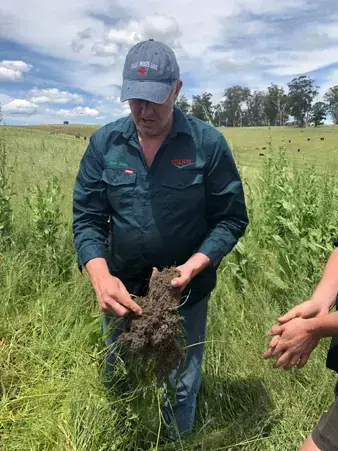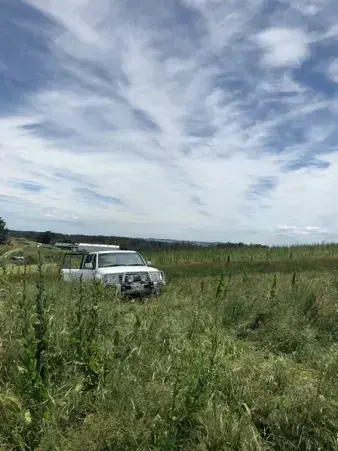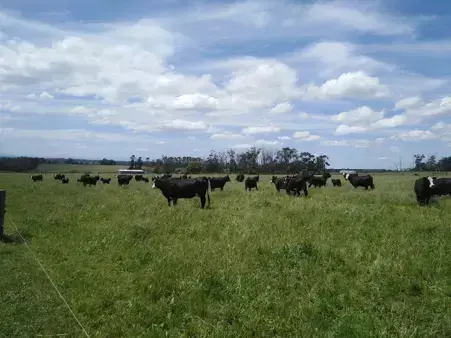‘Olsen’s Hallora’
A REGENERATIVE AGRICULTURE CASE STUDY
Niels and Marja Olsen with the help of their three sons Shaun, Jamie and Shane through careful management and the invention of the “SoilKee Renovator” have developed a property in Hallora, West Gippsland which produces healthy pasture year round. In 2019 the family were recognised for their exploits in sequestering soil carbon by being the first farm in Australia to be awarded carbon credits for doing so.
The Olsen family is focused on improving the health of their land to its maximum capacity, they are willing to share this journey with many land holders visiting their property each year to gain insight into how the Olsen’s have achieved spectacular soil and pasture improvements.
Olsen Family farm, Hallora VIC
FARM FACTS
ENTERPRISE: Angus cross cattle breeding
PROPERTY SIZE: 124 ha
AVERAGE ANNUAL RAINFALL: 100 mm
ELEVATION: 135 m
MOTIVATION FOR CHANGE: The over application of superphosphate fertilisers over the course of two years and the subsequent damage caused to their soil was the catalyst for Niels and Marja Olsen to reassess their farming strategy. Realising that healthy soil produces healthy food was a major factor in influencing their journey in becoming regenerate land managers.
INNOVATIONS
Regenerative landscape and livestock management regimes, including:
- Increase paddock numbers to facilitate rotational grazing
- Multi species pasture cropping
- Carbon and nitrogen soil sequestration
- Pasture growth improved to negate biannual “feed gaps”
- Utilisation of the “SoilKee Renovator Machine”
KEY RESULTS
Significant improvements in soil health measures such as moisture content, biological activity and soil carbon levels. Pasture growth has increased significantly with up to 20 tonnes of dry biomass per hectare grown each year. Observations of biodiversity have increased on the farm with the number of birds, frogs and other reptiles seen greatly increasing. Landslips and washouts have stopped occurring.
The Hallora Story
Niels and Marja Olsen with the help of their three sons Shane, Jamie and Shaun have been managing and operating the family farm in Hallora, Gippsland, Victoria since 1985. Previously, the property was used for dairy cattle with Niels making the switch to a herd of breeder cattle in 2008. Over the years Niels has worked a number of off-farm jobs, supplementing farm income. In 2012 Niels with the help of his family designed and patented a machine to improve soil health on his farm, the machine was named the SoilKee Renovator.

Niels Olsen showcasing soil structure and root depth gained from utilising the SoilKee Renovator.

Multi species pasture cropping at the Olsen Family Farm.
Background
Niels grew up on a farm not far from his current property; for many years he lived the life of a typical dairy farmer, milking twice daily 365 days a year. Niels farmed the way he had learnt in his youth, the traditional West Gippsland way: growing pastures in the good seasons of the year to harvest and store later to be fed out during the other seasons. This method of farming was labour and time intensive.
In the 1990’s Niels started and managed an earth moving business whilst keeping the farm running. The earth moving business proved to be quite successful and Niels made the decision to invest some of the profits back into the farm in the form of superphosphate fertiliser. In 1999 upon consultation from a local agronomist Niels purchased and applied a large quantity of super on his farm. The results were fantastic; pastures looked green and grew significantly more than they had the previous year. Niels decided to increase the dosage of super the following year expecting to achieve better pasture growth results. However, the complete opposite occurred; after applying the super the Olsen’s paddocks turned brown and stopped growing whilst his neighbour’s paddocks were green with fresh pasture growth.
This was the catalyst for the Olsen’s to recognise these practices were harming the landscape and seemed unsustainable in the long term. Marja and Niels were horrified at the damage they had inflicted upon their soil. Their response was to seek out guidance and training, they started attending workshops and field days focused on improving soil health. Armed with the knowledge they had gained from the numerous workshops and field days they set about regenerating soil health on their farm.
The Landscape
The property is comprised of 124 hectares split into 28 paddocks, the water supply consisting of dams and an ephemeral creek running through the property. The property sits at an elevation of 135m above sea level with an average annual rainfall of 1000 mm. Prior to land clearing in the late 19th century for agricultural purposes the landscape would have consisted of what is now classified as a damp/ wet sclerophyll forest. Numerous species of eucalyptus and acacia trees would have been present in the landscape, only Messmate (Eucalyptus obliqua) is present today.
The property consists of low slopes and rolling hills with an acidic red ferrosol soil. The pasture species at the time of purchase were mostly rye grasses and clovers with no native grass species present. Signs of ecological health in the soil such as worms were rarely observed prior to 2002. The pH of the soil ranged from 3.7-4.5 across the farm. Prior to the use of the “SoilKee Renovator” landslips and washouts regularly occurred across the property. Since the implementation of the “SoilKee Renovator”, no landslips or washouts have occurred on the property. The soil structure on the farm was improved by sowing deep rooted pasture species such as legumes, improving the structure of the soil which greatly reduced the risk of landslips and washouts.
Indicators of ecological health such as reptiles and frogs were not regularly observed on the farm prior to adoption of some regenerative management techniques, especially soil health, high soil carbon content, cover and hydration. In recent years frog numbers have increased significantly and they are now observed regularly. The dominant snake species on the property used to be the Eastern Brown (Pseudonaja textilis), since the increase in frog numbers Eastern Brown snakes are rarely sighted on the property instead Tiger snakes (Notechis scutatus) have become common. Frogs are the preferred food of Tiger snakes. The increase in frog numbers on the property directly coincided with the ceasing of chemical inputs.
Birds such as Ibis’s were commonly observed in the paddocks eating slugs and cockchafers, since adopting regenerative management techniques Ibis’s are rarely if ever seen on the farm. During a short walk on the property in November 2019 a Soils For Life ecologist observed 22 different species of birds. These species included birds from most of the trophic levels including raptors suggesting that the health of the landscape is in excellent condition.
Production
From 1985 till 2008 Niels operated the property as a dairy farm with a herd size of around 150, in 2008 Olsens stopped dairying and started a breeder operation and selling steers for slaughter. Initially they kept the same herd of dairy cattle and used them as a breeder herd due to the cost of replacing their herd entirely. In 2018 they replaced the herd of dairy cattle with a herd of angus crosses. Niels and Marja have utilised rotational grazing on the property from 2003 onwards, prior to 2015 the total yearly grazing time per paddock was eight weeks. This has increased the grazing time since 2015 to 12 weeks of the year due to increases in pasture production gained from sowing multi-species utilising the SoilKee Renovator. Niels has altered his production system from an animal-first perspective to soil first. Olsen’s focus is on improving the health of their soil through methods such as multi species cropping to encourage root growth and nitrogen and carbon intake from the air. Olsens consider fungal activity to be vitally important in improving soil health. They ensure that the soil is never deep ripped which can damage and stop fungal activity from occurring.
Prior to 2012 Niels had a concept in his mind which he thought could be the ideal method of farming for his property. However, he did not have the tools to trial the concept. His idea was that by utilising a machine which lightly disturbed the soil and planted crops concurrently, and twice a year, he could grow enough pasture biomass to feed his cattle year-round without having to cut and store fodder to be fed in the feed gaps of each season. In 2012 this idea came to fruition, Niels had built and designed a machine which he named the “SoilKee Renovator”. The machine consisted of angular blades which “broke” the earth rather than “cutting” it at minimal depth. The machine is utilised after grazing with 15-20% of biomass left from the grazing mulched straight into the soil speeding up the process. Essentially Niels had designed a machine which converted his pasture biomass directly into mulch after grazing. This completely reduced the need for any fertiliser application on the property.
Since 2012 Niels has not had to supplementary feed his livestock. The method of multi species pasture and cropping combined with the accelerated mulching enabled by the SoilKee Renovator, has significantly improved the health of the soil and the amount of pasture biomass produced each year. Niels has been able to grow 20 tonnes of dry biomass per hectare per year on some of his best paddocks, the less fertile areas of the property achieve 15 tonnes per hectare per year. The pasture growing season is now 9 months of the year. Undesirable pasture species such as kikuyu grass (Pennisetum clandestinum) which used to be present across the property has been out-competed by desirable species planted sowed with the SoilKee machine.
The Family
The Olsen Farm is an unusual farm in the sense that all three of Niels and Marja’s adult sons still work on the farm and in the family business. A lot of the production of the SoilKee machine is done on farm by the eldest son Shane, who is interested in manufacturing and design improvement. The middle son Jamie manages the farm with his father Niels and does contracting work driving the SoilKee Renovator on other properties. The youngest son Shaun helps in all aspects of the farm and family business. Marja manages the administration side of the farm and the business whilst Niels oversees operations. The sons are happy that they get to keep working on the family farm, Niels and Marja are pleased that their sons continue to play an active role in their lives.
Soil Health and Soil Carbon Sequestration
Commencing in 2016 detailed soil tests were undertaken on Hallora to meet the reporting requirements of the Australian Government’s Emissions Reduction Fund carbon abatement reporting requirements. Results for the 2017 reporting period showed Hallora measured 12.2 t/CO2e/ha and in 2018 this had increased to 13.7 tCO2e/ha. In early 2019 the Soilkee Farm became the first farm in the world (as far as we can ascertain) to be awarded carbon credits for sequestering carbon with their soil.
Increased carbon in the soil has correlated with increases in organic matter, water infiltration and holding capacity. Moisture and organic material were previously measured to reach a depth of 50cm in the soil, currently on some parts of the farm that depth has increased to 650cm. The pH of the soil has also improved from 3.7-4.5 prior to 2003 to currently measure at 5.5-7.9.
Nitrogen nodules on the roots of peas planted in the pasture are numerous and large in size and commonly observed. Worm castings are evident across the property and the soil structure has altered to feel spongey under foot. During autumn the fruit of fungi in the form of mushrooms and toadstools are visible across the paddocks indicating a healthy fungal biota existing beneath the soil.
Conclusion
Over 34 years of management the Olsens have continued learning about their landscape and the importance of the soil underneath it. Niels and family have altered their management practices to focus on building soil health and resilience across the farm to ensure long term viability. The most significant innovation that Niels has implemented on the farm is the use of the SoilKee Renovator, which has improved the health of their soil in conjunction with growing significantly more pasture biomass across the property. Other innovations include monitoring soil, introducing multi-species pasture and switching from dairy to beef.
The improvements the Olsen family have made to the property are an outstanding example of land holders implementing and practicing innovative regenerative management techniques particularly focused on nurturing soil health. The Olsen’s have achieved:
- Soil microbiology enhancements
- Soil hydration improvements
- Improvements in carrying capacity of land
- No low season feed inputs
- Air penetration of soils
- Biodiversity
- Family wellbeing
- Carbon sequestration in the soils
- Australian Carbon Credit Units which can be traded.
Narrative summary
The Olsen’s started viewing and managing their property as a system and as a result the ecology of the farm has improved dramatically, so too have the social benefits as the family that works together, stays together.
Ecological summary
The ecology of the Olsen Family Farm speaks for itself, the soil is thriving, full of worms and root systems packed with nitrogen nodules and soil carbon levels are excellent and still rising. Above the ground a diverse range of birds and frogs are now regularly seen in the grassy paddocks.
Economic summary
Despite the publicity about the Olsen Family Farm being the first in Australia to acquire ACCU’s under the federal governments Emissions Reduction Fund, the fact remains an integrated approach to regenerative agriculture pays off. Increasing natural capital and the resultant ecosystem service benefits provides greater productivity and landscape resilience, the ACCU’s are the cream on top!
Social summary
The entire family works together on managing the property and their associated business ventures. Being able to work on the family farm into adulthood provides each of the three sons a great deal of job satisfaction. Needless to say Niels and Marja are pleased to have all three of their sons around.





